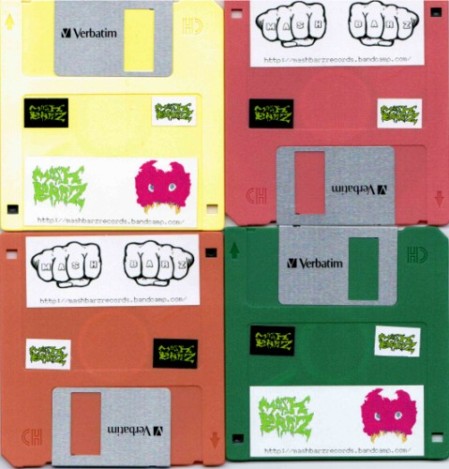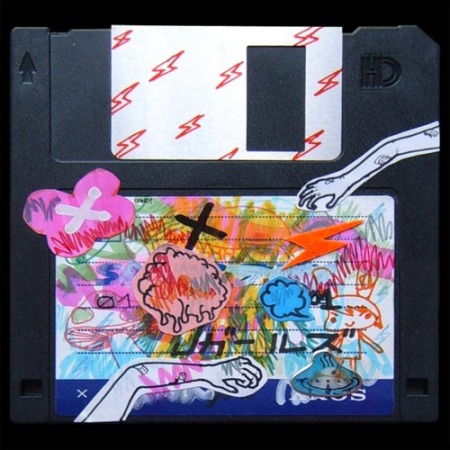
Releasing music on a cartridge that needs an old 8-bit platform to work, might seem like the worst way of releasing music today. But if you think about it a bit more…. A cartridge takes the best parts of the software-world and the hardware-world: You get a good-looking physical object, and it doesn’t have to contain only static recordings that are the same forever and ever.
The first cartridge release I heard about was Vegavox, a NES-cartridge made by Alex Mauer in 2007 with a basic interface to select songs. The follow-up, Vegavox II (below) was more refined with custom moving graphics for each song.
This looks similar to music videos, but under the hood it’s actually quite different. A video is a recording – a stream that plays from A to B the same way every time. Vegavox II on the other hand, is code and instructions that requires a very specific platform for playback. It’s more like a theater than a movie. Potentially, the user/viewer can ruin the whole thing by interrupting and destroying.
In the 1960’s this was a politically fueled idea that became prevalent in the computer arts to come. The power of the user. Today there are of course countless apps, games and sites with playful audiovisual interaction. But there’s not a whole lot of musical apps and situations where the composer really tries to give the user power over their own composition. Ah, the neurotic narcissism of music folks, eh? ^__^
+++
In the mid-1980’s, people started to rip game music and make compilations for the user to choose songs and trigger sound effects. The teenagers in the burgeoning demoscene started to make their own music, and by 1991 the music disk was an established format with quality releases such as Bruno’s Box 3, Crystal Symphonies and His Master’s Noise and plenty of gritty hip house megamix type of things, like Tekkno Bert.
These music disks normally pretended to be recorded music, even if it wasn’t. Under the hood there were notes and instruments being played live by software/hardware. You can see it in The Top Boys’ music disk above, where the notes are “played” on the keyboard. Theoretically the user could change each and every note, unlike a video where you can’t change the music at all. Music disks normally didn’t allow that, but commercial releases like the Delta Loader and To be on Top did.
While musical interaction almost seemed (and seems) a bit sinful to the genius music brain, visual interaction was (and is) more common. Back in the 1980’s there was 8-bit generative visuals like Jeff Minter’s Psychedelia (and other acid-ish stuff hm) that taps into earlier things like Atari’s Video Synthesizer.
Returning to the topic of cartridges and jumping ahead to 2016, RIKI released the Famicom-cartridge 8bit Music Power with music by eg Hally and Saitone. The user could interact with the music aswell as play games, and there were visualizers for the music. It’s like a mixture of a music disk and interactive music games.
Musical user interaction is still a rather unexplored field. Perhaps the user can mute instruments (8bit music power), move back and forth through a timeline (jazz.computer, dynamic game music) or trigger sounds/visuals in a game/composer environment (Playground). One recent interesting example is Yaxu’s Spicule, where the user can change the algorithms that compose the music in realtime.
A while back, Ray Manta at DataDoor came up with the idea to make a C64-cartridge and continue this exploration. So me, 4mat and iLKke got to work (and also did this). DUBCRT is our attempt to merge ideas from these different eras. There’s some music disk vibes to it, but in a kind of abstract and 1960’s modernist way. For each track there is a visualizer that spits out PETSCII-graphics, based on the music that is played.
The interaction is not all rationally easy to understand, but you can change the parameters of the visuals and (in a hidden part) change which audio sequences are played for each voice. You can also superimpose audio waveforms onto them, which means that you can pretty much ruin the song completely. A big plus! Nobody’s in charge. You can hear an example in Tim Koch’s remix in the album-release on Bandcamp.
All of this fits in 64 kilobytes, which means less than 8 kilobyte per song/visual. 4mat is known to only need 23 bytes to make good C64-stuff, and I tried to optimize my songs to fit aswell. All of ilKke’s graphics are in PETSCII, which also helped to keep the filesize down.
Here’s hoping to more absurd musical power interactions in the future! And since DUBCRT sold out in three hours, it actually seems like more people see this is as the best of two worlds. He he he…










